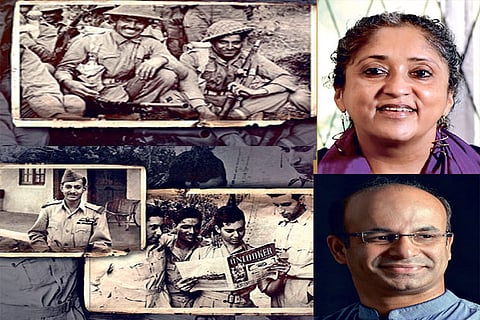

Chennai
“The idea of this streaming platform is that our country has an enormous amount of positive stories but these stories are not brought out in an organised fashion. As a result, wonderful stories get lost in the diverse discourse of this country. Inspiring stories, ancient to present, of India and Indians are being lost from the mind and conscience of the Indians today. Hence our initiative to bring forward these stories,” says Ganesh.
During his research work, Ganesh met Annu Palakunnathu Matthew, a photography professor, who is working on an art project to highlight the unaddressed history of soldiers. “She has been doing incredible work and I thought of converting her findings into a short curated digital film for a wider audience across the world. The five-minute film is titled Searching for The Unremembered: The Forgotten Indian Soldiers of World War 2. In the film, Annu is narrating the story of how she wanted to tell the stories of the families of World War 2 soldiers, what is her mission and so on. We also got some photographs and videos and have put together everything in a film format,” he adds.
The story of the unremembered Indian soldiers who fought in World War 2 came about through Annu’s research on the partition. “The fact that 2.5 million Indians fought in World War 2 and I find that number staggering because it is a huge contribution and my question always been and continue to be is why is it not part of our larger history? The story is untold for a lot of complicated reasons and I am still unravelling some of those reasons. But from my understanding and talking to different families, a huge issue was that these 2.5 million Indians were taking orders from the British colonisers and since India and South Asia became independent soon after they didn’t want to acknowledge that contribution. I am interested in illuminating this hidden history because I think the contributions of the 2.5 million Indians need to be acknowledged without taking any political sides. I think art is a way to be able to do that — through the visuals, create interest in this history and learn more about these people as individuals rather than just a statistic. I have been giving talks all over the country to different kinds of audiences about the work in progress, but hopefully, to activate a base so that they would send me more photographs and stories.
“One of the things that I am very clear about is that I wanted to show this work both in India and in England because both countries are complicit for why this history is not known. And I think for the younger generation and people outside of the military, this project can pique their interest to learn more about these people and our histories,” says Annu.
The professor notices that the generosity of the people towards her project has been amazing. “Many helped me collect these photographs. One of my goals is not to erase any history but to add to the history that we already know. In terms of India getting Independence, we all know about the Quit India Movement; because of the Red Fort trials, we know of the Indian National Army (INA). I would add that these 2.5 million Indians who fought for the allies and were critical for winning World War 2 should also be acknowledged and be part of our larger history as we move forwards,” she says through the film.
Visit news.dtnext.in to explore our interactive epaper!
Download the DT Next app for more exciting features!
Click here for iOS
Click here for Android